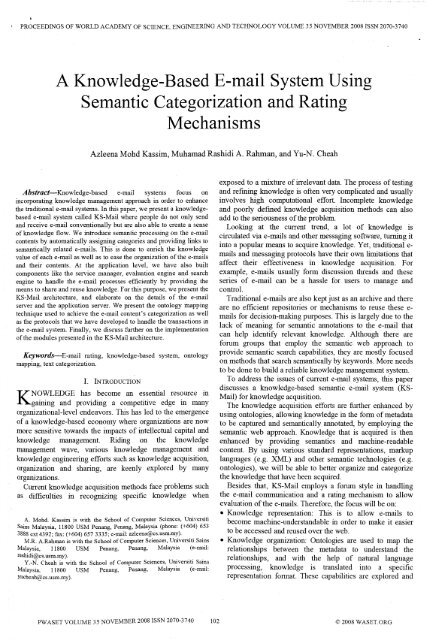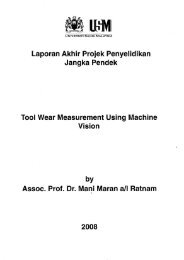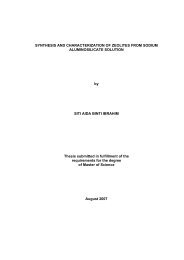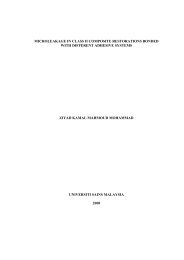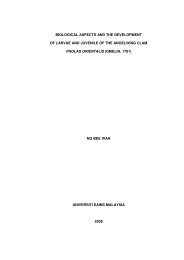A Knowledge-Based E-mail System Using Semantic ... - ePrints@USM
A Knowledge-Based E-mail System Using Semantic ... - ePrints@USM
A Knowledge-Based E-mail System Using Semantic ... - ePrints@USM
You also want an ePaper? Increase the reach of your titles
YUMPU automatically turns print PDFs into web optimized ePapers that Google loves.
PROCEEDINGS OF \VORLD AC.A.DEMY OF SCIENCE~ENGINEERING AND TECHNOL()GY VOLUME 35 NOVEMBER 2008 ISSN 2070-3740<br />
A <strong>Knowledge</strong>-<strong>Based</strong> E-<strong>mail</strong> <strong>System</strong> <strong>Using</strong><br />
<strong>Semantic</strong> Categorization and Rating<br />
Mechanisms<br />
Azleena Mohd Kassim, Muhamad Rashidi A. Rahman, and Yu-N. Cheah<br />
Abstract-Kllowledge-based e-<strong>mail</strong> systenls focus on<br />
incorporating knowledge nlanagement approach in order to enhance<br />
the traditional e-<strong>mail</strong> systems. In this paper, \ve present a k110\vledgebased<br />
e-<strong>mail</strong> systelTI called KS-Mail where people do not only send<br />
and receive e-<strong>mail</strong> conventionally but are also able to create a sense<br />
of knowledge tlo"v. \Ve introduce semantic processing on the e-nlail<br />
contents by automatically assigning categories and providing links to<br />
semantically related e-lnails. This is done to enrich the kno,;vledge<br />
value ofeach e-<strong>mail</strong> as well as to ease the organization ofthe e·-lnails<br />
and their contents. ,A.t the application level, we have also built<br />
conlpollents like the service manager, evaluation engine and search<br />
engine to handle the e-<strong>mail</strong> processes efficiently by providing the<br />
means to share and reuse kno\vledge. For this purpose, we present the<br />
KS-~1ail arc.hitecture, and elaborate on the details of the e-lnail<br />
server and the application server. \Ve present the ontology mapping<br />
technique used to achieve the e-lnail content's categorization as well<br />
as the protocols that \ve have developed to handle the transactions in<br />
the e-<strong>mail</strong> system. Finally, we discuss further on the impletuentation<br />
of the Inodules presented in the KS-:~'fail architecture.<br />
KeYJvords-E-lnail rating, knowledge-based system, ontology<br />
mapping, text categorization.<br />
I. IN1RODUCTION<br />
KN()WLEDGE has become an essential resource in<br />
gaining and providing a COIllpetitive edge in lllany<br />
organizational-level endeavors. This has led to the emergence<br />
of a knowledge-based econonlY where organizations are now<br />
nl0re sensitive towards the ilnpacts of intellectual capital and<br />
kno\vledge managenlent. Riding on the knowledge<br />
management wave, various knowledge lllanagement and<br />
kno\vledge engineering efforts such as kno\vledge acquisition,<br />
organization and sharing? are keenly explored by many<br />
organizations.<br />
Current knowledge acquisition methods face problelTIS such<br />
as difficulties in recognizing specific knowledge when<br />
A. 1tlohd. Kassim .is with the School of Conlputer Sciences, Universiti<br />
Sains Malaysia, 11800 US:rv1 Penang, Penang, ~lalaysia (phone: (+604) 653<br />
3888 ext 4392; fax: (+604) 657 3335; e-<strong>mail</strong>: azleena(g>.cs.usm.my).<br />
~LR. A.Rahman is 'with the School of Conlputer Sciences, Universiti Sains<br />
Malaysia, 11800 USM Penang, Penang, Malaysia (e-nmil:<br />
rashidi@cs.usnl.lny).<br />
Y.-N. Cheah is with the School of Conlputer Sciences, Universiti Sains<br />
Malaysia~ 11800 USM Penang, Penang, I\rfalaysia (e-<strong>mail</strong>:<br />
yncheah@cs.usm.my).<br />
exposed to a luixture of irrelevant data. The process of testing<br />
and refming kno\vledge is often very complicated and usually<br />
involves high computational effort Incomplete knowledge<br />
and poorly defined knowledge acquisition methods can also<br />
add to the seriousness ofthe problenl.<br />
Looking at the CUITent trend, a lot of knowledge is<br />
circulated via e-<strong>mail</strong>s and other messaging software, turning it<br />
into a popular means to acq~ire knowledge. Yet, traditional e<br />
lllails and Inessaging protocols have their O\Vll limitations that<br />
affect their effectiveness in knowledge acquisition. For<br />
example, e-<strong>mail</strong>s usually forlll discussion threads and these<br />
series of e-luail can be a hassle for users to tuanage and<br />
control.<br />
Traditional e-<strong>mail</strong>s are also kept just as an archive and there<br />
are no efficient repositories or lllechanisms to reuse these e<br />
<strong>mail</strong>s for deci~ioil-making purposes. This is largely due to the<br />
lack of meaning for semantic mmotations to the e-lnail that<br />
can help identify relevant kno\vledge. Although there are<br />
fOfUIU groups that employ the setuantic web approach to<br />
provide selnantic search capabilities, they are mostly focused<br />
on methods that search senlantically by ke)'\vords. More needs<br />
to be done to build a reliable kno\vledge manageluent systelu.<br />
To address the issues of current e-Illail systems, this paper<br />
discusses a knowledge-based semantic. e-<strong>mail</strong> systenl (KS<br />
Mail) for knowledge acquisition.<br />
The knowledge acquisition efforts are further enhanced by<br />
using ontologies, allowing knowledge in the torm of metadata<br />
to be captured and semantically annotated, by eluploying the<br />
semantic web approach. <strong>Knowledge</strong> that is acquired is then<br />
enhanced by providing semantics and machine-readable<br />
content. By using various standard representations, luarkup<br />
languages (e.g. XML) and other semantic technologies (e.g.<br />
ontologies), we will be able to better organize and categorize<br />
the knowledge that have been acquired.<br />
Besides that, KS-Mail elnploys a foruln style in handling<br />
the e-Illail communication and a rating mechanism to allow<br />
evaluation ofthe e-luails. Therefore., the focus will be on:<br />
• <strong>Knowledge</strong> representation: This is to allow e-<strong>mail</strong>s to<br />
becolue machine-understandable in order to luake it easier<br />
to be accessed and reused over the web.<br />
• Kno\vledge organization: Ontologies are used to map the<br />
relationships between the metadata to understand the<br />
relationships, and \vith the help of natural language<br />
processing, kno\vledge is translated into a specitIc<br />
representation fonnat. These capabilities are explored and<br />
P\VASET VOLU1-1E 35 NOVElv1BER 2008 ISSN 2070-3740 102 © 2008 \VASET.ORG
Y Y"_N· ~<br />
Y __<br />
PR()CEEI)INGS OF \V()RLD AC.A.DEMY OF SCIENCE~ ENGINEERING ALND TECHNOLOGY 'VOLlTME 35 NOVEMBER 2008 ISSN 2070-3740 f<br />
extended to enable categorization of the e-Inail content,<br />
using the semantic \veb approach employed in a previous<br />
SEMbiog project (1].<br />
• <strong>Knowledge</strong> sharing and reuse: We introduce an architecture<br />
that allows collaborative knowledge-sharing capabilities?<br />
allo\vmg kno\vledge to be evaluated/rated, and reused from<br />
tilne to time.<br />
In KS-Mail, we expand the ftmctiollalities of a previous<br />
systetTI called KM-Mail [2], \vith the features mentioned.<br />
earlier as \vell as by reconstructing the application seIVer. The<br />
reconstruction of the application server is achieved by<br />
enhancing its components such as the selVice manager,<br />
evaluation engine and the search engine. We have also<br />
unproved the user interface to overcome problems related to<br />
massive e-<strong>mail</strong> thread~ and ill-managed e-<strong>mail</strong>s.<br />
II.<br />
RELATED WORK<br />
McDo\vel1, Etzioni, Halevy, and Levy [3] proposed a<br />
setnantic web approach to e-<strong>mail</strong> luessaging that uses RDF<br />
queries tied to SOine descriptive texts. In order to present the<br />
class of semantic e-<strong>mail</strong> processes, they defined logical and<br />
decision-theoretic models which autonlatically infer ,vhich e<br />
nlail responses are to be accepted and compute optimal<br />
message-handling policy in polynomial time respectively.<br />
In another work, a semantically enhanced e-luail systelTI is<br />
developed where the ontology is utilized for speech acts, and<br />
non-deterministic models are presented in order to help users<br />
to decide the actions after sending or receiving e-<strong>mail</strong>s [4].<br />
This aims to overcome inioffilation overload as 'Yell as<br />
processing delays upon respondiIlg to different Inessages. The<br />
system is presented by creating its O\Vl1 e-<strong>mail</strong> speech act<br />
ontology. It is suggested that semantic annotations to an<br />
individual e-Inail tnessage can be used to enhance a semantic<br />
e-<strong>mail</strong>, which is hoped to be used to predict reactions using its<br />
predictive model.<br />
In an efTort to overcome unsolicited e-<strong>mail</strong>s (spam):> and<br />
protect the privacy ofe-nlail addresses and individual identitY1<br />
there are SOine efforts on semantic e-<strong>mail</strong> addressing being<br />
carried out. SE..A. is used to address e-luails to a sen1antically<br />
defined set of entities [5]. SEA works to keep track of some<br />
descriptive attributes that are semantically specified to each<br />
recipient or group and is able to change dynamically.<br />
WalTen [6] discussed the use of the senlantic web for<br />
knowledge management and the benefits and significance of<br />
using ontologies in the semantic \veb. Warren highlighted the<br />
importance of converting the selnalltic web into a business<br />
process value and allowing it to be available explicitly.<br />
Warren described that the building of a knowledge<br />
nlanagement environment starts fron1 a scenario, \vhich<br />
utilizes certain technologies to achieve the goal. Ifappropriate<br />
technologies are applied to \vork alongside sen1antic web, it<br />
can selVe as a knowledge management scenario that can<br />
fi.lnction as a search mechanisln.<br />
Some efforts have also been carried out to explore the<br />
potentials of groUP\Vare technology [7] to handle<br />
organizational knowledge. The proposed groupware is made<br />
up ofcOlnponents for dOCUlnellt Inanagement, bloggmg and e<br />
Inail that ~'enforces" kno\vledge nlanagement within the<br />
organization. This prototype project looks fonvard to<br />
enhancements in terms of the groupware's interactivity~<br />
connectivity and personalization.<br />
In. KS-MAILARCHITECTURE<br />
As with the previous KM-Mail [2] system, we maintain the<br />
four-layer architecture but have simplified as \vell as added<br />
some new features to it (see Fig. 1). The two nlain modules<br />
are:<br />
• E-<strong>mail</strong> server: This module performs selnantic processing to<br />
extract relevant keywords fronl the e-<strong>mail</strong> text and to fmd<br />
relationships bet\:veen e-nlails.<br />
• Application server: This luodule provides the basic features<br />
of an e-nlail system and provides a mec.hanism to .users to<br />
evaluate or rate e-<strong>mail</strong>s as well as to searc.h for e-Inails that<br />
contain particular kno\vledge content.<br />
The KS-Mail repository is also an ilnportant module in the<br />
system where it stores the e-Inail, discussion threads as well as<br />
the XML· file for the semantic functionalities.<br />
~,<br />
..-» ... «~~;:. ..........;N'" *#. ""' .............: ..... - ............. - ••--- v.<br />
~ [ lNTERN~;SERVlC~ .... l<br />
:;.:':'~.h:':V::":~::.::::::;·~. ,. __ ~ ------- ~ __ .~ :~ _H---I.. __ H.Y<br />
.A.<br />
E-1vfail Server<br />
_N~__UH __<br />
,//:E<strong>mail</strong> Server ..' Application Ser#!f·~'·'\~<br />
Fig. 1 KS-1tluil Architecture<br />
The e-nlail server performs t\VO functions: (1) ontology<br />
mapping and (2) semantic linking. As a result, this component<br />
produces categorizations ofthe e-<strong>mail</strong> content.<br />
Ontology lv/opping<br />
To assist in organizing the e-<strong>mail</strong> contents as well as<br />
acquiring knowledge embedded in it, we use the Ontology<br />
Web Language (OWL)~ particularly OntoSem. The OntoSem<br />
ontology comes in a tangled tree of concepts~ using its OVill<br />
metalanguage to desclibe the meaning of objects and events<br />
[8].<br />
For this purpose, natural language understanding \vill<br />
influence the semantic representation, inference and<br />
knowledge representation during the process. In this case1<br />
P\VASET VOLUlv1E 3S NOVEMBER 2008 ISSN 2070-3740 103 © 2008 \VASET,ORG
PROCEEDINGS OF \VORLD AC.ADEMY OF SCIENCE. ENGINEERING A.ND TECHNOLOGY V()LlJNIE 35 NOVEMBER 2008 ISSN 2070-3740<br />
word statistical distribution technique is used to categorize the<br />
e-luail contents. Subsequently, the metadata in Ont
PROCEEDINGS OF WORLD ACADEMY OF SCIENCE. ENGINEERING i\.ND TECHN()L()(iY VOLlJrvIE 35 NOVEMBER 2008 ISSN 2070-3740<br />
interface., a text box is provided in the e-lnail where the user<br />
can input their comments regarding the ans\ver given.<br />
The KS-Mail repository stores all the rating or connnents<br />
that are provided by the e-<strong>mail</strong> recipients. This is continuously<br />
being updated. Each rating or comment will be linked to the<br />
respective e-<strong>mail</strong>replies via the KS-Mail-ID. Fig. 3 shows the<br />
workflow for "Read and Evaluate".<br />
Read com:mentoranswer<br />
Evaluate<br />
Submit rating and comments<br />
Rating ·and com:ment processed<br />
and stored in repository<br />
Answer with evaluation in<br />
repository<br />
IV.<br />
I:rvIPLE!v1ENTATION<br />
For each matching cyc.le, \ve will only map 4 steps up the<br />
ontology hierarchy. Therefore the value ofL is initialized to 4.<br />
Then, the search llloves up to the superclass of the earlier<br />
matched ontology class.<br />
\Vhen a superclass is found., Pc is calculated for the<br />
matched superclass. Here, the value D,v is still the sanle but<br />
since the mapping is now a step higher the ontology hierarchy,<br />
the value of L is decreased by 1. The cycle \vi11 halt if no<br />
superclass can be found or when L = 0 (after four levels of<br />
ontology classes are mapped).<br />
The weight for each lnetadata or ontology class mapped is<br />
calculated, and this is repeated for all the ke)'\¥ords. A class in<br />
the ontology can be mapped more than once if it is a<br />
superclass of more than one keyword. If this is the case, its<br />
weight will be a COlllbination ofall the weights.<br />
After completing the ontology mapping, a sigmoid function<br />
(see equation 2) is applied on each of the Pc values of the<br />
categories to obtain a nonnalized value, Sc, before listing the<br />
Inetadata in descending order (the higher the Sc value, the<br />
higher chance for that class to be chosen as a category for a<br />
particular e-lllail content).<br />
1<br />
sc=---<br />
Fig. 3 Process flow for "Read and Evaluate~' (2)<br />
As for the search engine, a nonnal keyword-based search<br />
will be used to retrieve e-<strong>mail</strong>s fi-oIn the archives and the<br />
knowledge repository. The categorization and linking by the<br />
semantic processing is conlbined with this function for a<br />
directed search. With the evaluation facility, search engine<br />
and the repository working together, it will fOfill a tool that<br />
can be effectively used for knowledge management.<br />
A. E-Mail Server<br />
In this section, we provide more details on the ontology<br />
mapping and semantic linking component ofthe e-<strong>mail</strong> selver.<br />
Ontology A/opping<br />
The ontology mapping technique effectively categorizes the,<br />
e-luail content. The process of categorizing the e-<strong>mail</strong> content<br />
is carried out as follovvs:<br />
First, we read the text tl'om the user's e-Inail entry, where<br />
all \vords are considered as individual keyvvords. Then, all<br />
stop-words are removed. When \ve remove stop-\vords (e.g.<br />
deterininers, auxiliaries and preposition), we are eliminating<br />
words which are less meaningful to the content. The<br />
reluaining words are then applied \vith the word statistical<br />
distribution to count the weight ofeach word.<br />
The keywords (with their respective weights) are then<br />
Inapped to the OntoSem ontology. To do this., we match each<br />
weighted word in the list to the hierarchy ofclasses (concepts)<br />
in the ontology. When a match is tound, the probability (P)<br />
(see equation 1) ofthat class being a category is calculated..<br />
Pc=DwxL<br />
where C is the matched ontology class, 1-'V is the vveight of the<br />
word D, and L is the level ofexploration.<br />
(1)<br />
1+ e-(Pc )<br />
In equation 2:1 \ve set a threshold value, T. The categories<br />
with /)c Ineeting or exceeding T will be chosen as one of the<br />
categories for the e-nlail. In this case, it is possible for an e<br />
<strong>mail</strong> to have multiple categorizations (having more than one<br />
categoly) as long as their weights exceed T.<br />
Finally, the categories are checked against a predefined list<br />
of categories that are "too general" to be considered as a<br />
category and are removed (these lnay be categories which are<br />
too high up the ontology hierarchy).<br />
The e-Inail can novv be stored. in the KS-Mail repository in<br />
XML forInat (see Fig. 4).<br />
<br />
ben3<br />
<br />
Fig. 4 Portion ofthe XML file stored in the KS-Mail repository<br />
~Selnantic Linking<br />
When the categories ofthe e-Illail have been identified, the<br />
e-<strong>mail</strong> autoluatically becolues a possible senlantic.link: to other<br />
e-<strong>mail</strong>s within the same e-<strong>mail</strong> account. 111erefore, when an e<br />
<strong>mail</strong> is created or retrieved for viewing? the XML tile in the<br />
KS-Mail repository is parsed through.<br />
TIle e-lnail server nlanages the search by dynamically<br />
obtaining the links contained in the tags ofother e<br />
lnails' XML entries that have the SaIlle categories. This<br />
matched by cOlnparing the tag of the<br />
viewed/created e-<strong>mail</strong>s with the existing ones (see Fig. 5).<br />
P\VASET VOLUME 35 NOVElY1BER 2008 lSSN 2070-3740<br />
105<br />
© 2008 \VASET.ORG
RROCEEDINGS OF \VORLD AC.ADEMY OF SCIENCE~ENGINEERING A.ND TECHNOLOGY VOLUNIE 35 NOVEMBER 2008 ISSN 2070-3740<br />
disturbing arti.cle £0;:: me<br />
313 -<br />
ZOC8->JS=11<br />
~.he fore.s<br />
--~-----------------------------------------_:#P<br />
Fig. 5 Matching categories in the X1vIL file<br />
When a nlatch is found, the tag \vill refer to the<br />
tag to look for the identifier. The stores<br />
the Unified Resource Identifier \\rhich \vil1 be used to point to<br />
the specific e-<strong>mail</strong> and be linked to it. Thus, the content of<br />
these semantic.ally related e-<strong>mail</strong>s are reused when viewed by<br />
the user.<br />
B. ...4pplication Server<br />
As S0011 as an e-<strong>mail</strong> has been sent/posted:;> the e-<strong>mail</strong> server<br />
\vill be invoked. and the e-lnail's text will be senlantically<br />
processed. The IDs of each e-<strong>mail</strong> are also stored in the<br />
repository. Each e-<strong>mail</strong> posted by the user \vill be given two<br />
different IDs. The first ID is referred to KS-Mail-ID generat.ed<br />
by the KS-Mail server, while the second ID is the reference ill<br />
that functions as a pointer to the original e-<strong>mail</strong> \vhich the user<br />
is replying to (see Fig. 6).<br />
first E<strong>mail</strong><br />
KS-PvlaH..;lf): KS001:<br />
Re·fere=nce·-t~D:: nuB<br />
:Re-ply to First E<strong>mail</strong><br />
KS-P'>j4.ad-~liD: KSn02<br />
Refe-rence-J:D.:K-S{f01<br />
Fig. 6 KS-Mail-ID assignment Inechanisnl<br />
These t\.vo difIerent IDs are ilTIportant in the evaluation<br />
lllechanism as each e-<strong>mail</strong> ill will be used as a reference.<br />
\Nnenever an evaluation process is cOlnpleted:;> the evaluation<br />
scores in a rating tornl and comnlents \vill also be recorded<br />
and stored together. TIle process is repeated each time new<br />
evaluationsCOlTIe in, cOlnbining the details of the overall<br />
scores and total rating for each e-<strong>mail</strong>.<br />
V. CONCLUSION<br />
In this paper, we presented a combined approach to<br />
enhance an e-<strong>mail</strong> systeln through semantic categorization and<br />
rating. For this purpose, we have employed web technologies<br />
such as the semantic \veb, as well as ontology and natural<br />
language processing (NLP) techniques.<br />
By using selnantic teclmology, we allow knowledge to be<br />
acquired frOlTI the e-inail and categorized accordingly. This<br />
acquired knowledge is then stored and reused to promote<br />
knowledge sharing mnongst users. The semantic link<br />
subsequently provides easy access to related e-luails within<br />
the user's account. Naturally, users cannot view or link to e<br />
<strong>mail</strong> that is not within his/her KS-Mail ace·ount to ensure<br />
security and privacy.<br />
\\tl1at is exciting is that we have observed that KS-Mail<br />
effectively brings older e-lnails to the attention of the user via<br />
the semantic links that are created. This happens whenever a<br />
new e-lnail is created or received. This opens a whole new e<br />
<strong>mail</strong>ing experience for the user fioln a knowledge<br />
management point of view. The user is now able to calTY our<br />
kno\vledge acquisition, organization and reuse just by using<br />
the KS-Mail system.<br />
In sUlnmary, the value added concept of KS-Mail is the<br />
franle\¥ork that highlights the ilnportance of the e-<strong>mail</strong>'s<br />
content. We also emphasize the significance of knowledgerich<br />
e-<strong>mail</strong> through rating and searching mechanisllls.<br />
In the fut.ure, we·hope to expand the features ofKS-Mail to<br />
incorporate semantic blogging [7]. In this future enhancement,<br />
it is hoped that an improved ontology mapping process can be<br />
enlployed. Through the selnantic blogging exercise, it may<br />
even be possible to tease tacit knowledge froln experts <br />
which is something that is much desired in a knowledge<br />
manageillent context.<br />
REFERENCES<br />
[1] A. Mohd Kassinl and Y.-N. Cheah, H<strong>Using</strong> <strong>Semantic</strong> Web.. Ontologies<br />
and Blogs for <strong>Knowledge</strong> Identification, Organisation and Reuse,'~<br />
International Conference on Electrical Engineering and InfonnaliL'S<br />
2007 (ICEEI2007), Bandung, Indonesia. June 17-19, 2007, pp. 691<br />
694.<br />
[2] K.G. Linl and Y.-N. Cheah, "Sharing, Evaluating and Organizing E<br />
1vlail: The KM-I\.1ail A.pproach," The 3 rd International Conference on<br />
information Technology in _A.sia~ Sarawak, Malaysia, July 17-18, 2003,<br />
pp.112-117.<br />
[3] L. McDowell.. O. Etzioni, A. Halevy, and H. Levy.. ~;'<strong>Semantic</strong> e-<strong>mail</strong>,"<br />
Proceedings of the 13th international conference on ~Vorld PVide<br />
r¥eb(Tf/JV~V '04}. New York.. NY, USA, May 2004.. pp. 244-254.<br />
[4] S. Scen'i~ B. Davis. and S. Handschuh, Hlmproving E-Inail Conversation<br />
Efficiency through Selnantically Enhanced E-lnail," Proceedings ofthe<br />
18th International Conference on Database Clnd E~'rperr <strong>System</strong>s<br />
Applications (DEX4 2007}, Regensburg, Gemlany, Septenlber 3-7,<br />
2007,pp.490-494.<br />
[5] !vI. Kassoff, C. Peine, LJv1. Zen, and}.lI. Genesereth. ~'<strong>Semantic</strong> E-<strong>mail</strong><br />
Addressing: Sending E-<strong>mail</strong> to People, NotStrings,"AA.AI 2006 Fall<br />
Symposium, Washington~ DC~ October 13-15,2006.<br />
[6] P. Wan"en, '''<strong>Knowledge</strong> Management and the Selnantic Web: From<br />
Scenario to Technology," IEEE Intelligent <strong>System</strong>s) 2006, Vol. 21.~ pp.<br />
53-59.<br />
[7] Y.-N. Cheah, "'Enhancing Groupw'are for K110\¥ledge Management,"<br />
F~fth International C01?(erence on Infonnation Technology in Asia<br />
(LiTA 2007), Sanl\¥ak, Malaysia, July 9-12,2007, pp. 145-150.<br />
[8] M. McShane, S. Nirenburg and S. Beale, "An hnplemented, Integrative<br />
Approach to Ontology-<strong>Based</strong> NLP and Interlingua," Working Paper 06<br />
05. Institute for Language and Infornlation Technologies, University of<br />
1v1aryland Baltimore County, USA, March 8, 2005.<br />
P\VASET '/OLU1-1E 35 NOVElY1BER 2008 ISSN 2070-3740 106 © 2008 WASET.ORG


